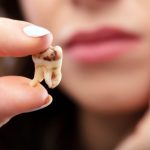Tooth Decay – Do you need Dental Fillings?
 Dental caries, more commonly known as tooth decay, is the loss of minerals from the ‘enamel’ and ‘dentine’ layers of the tooth. When the sticky biofilm called plaque attaches to the tooth, bacteria from within this biofilm begin to convert the sugar from your diet into acid.
Dental caries, more commonly known as tooth decay, is the loss of minerals from the ‘enamel’ and ‘dentine’ layers of the tooth. When the sticky biofilm called plaque attaches to the tooth, bacteria from within this biofilm begin to convert the sugar from your diet into acid.
These acid attacks result in weakened, demineralised tooth structure and if left unaddressed can eventually cause holes or cavities.
Although your oral hygiene (brushing and flossing) plays a big role in prevention of tooth decay, other factors including your diet, your saliva flow and your exposure to fluoride also interplay to affect your risk of tooth decay.
Diagnosis:
Tooth decay is a major cause of toothaches in most adults and children. This decay, if left untreated, can progress to the layers beneath enamel, eventually reaching the nerves and blood supply of the tooth, resulting in pain.
It is best to not wait until pain is experienced before visiting your local dentist near me as this often results in more complex and costly treatment options.
It is best to prevent tooth decay from occurring because once natural tooth structure is lost, there is no natural way of recovering it, at which stage dental treatment is required. Regular check-ups and cleans will allow your Hornsby dentist/oral health therapist to detect very early signs of acid attacks before any fillings are needed (with the aid of dental x-rays).
There will not always be a visible hole in your tooth as the decay will often occur in between your teeth or from within the deep grooves of your biting surfaces. When tooth decay is diagnosed early, the treatment options are often less invasive and longer lasting.
Treatments:
-
Concentrated Fluoride:
During the early stages of tooth decay, concentrated fluoride can be applied professionally to prevent demineralisation and initiate remineralisation of tooth structure. At this point, acid attacks are only affecting the enamel and can be reversed, however if not addressed can quickly progress to the underlying tooth layers. This can either be a foam, gel, or varnish application.
-
Restorations (fillings):
Depending on the extent of tooth decay, your dentist/oral health therapist may offer some local anaesthetic during a filling to prevent pain and ensure comfort. The decayed portion of the tooth will need to be removed and then filled so it can return to its normal shape and function.
Some types of dental filling materials include glass ionomer cement (GIC), composite resin (tooth-coloured fillings), amalgam (silver), porcelain and gold (rarely used).
In cases of extensive decay or breakdown of the tooth where little tooth structure remains, a custom-fitted crown (tooth cap) may be needed. If well cared for, crowns can provide better protection of the natural tooth and can last longer than fillings.
If the decay has extended to the tooth pulp (where the nerves and blood supply are contained), then root canal treatment may be required to save the tooth. This involves removing the dental pulp and filling the empty chamber with filling material to seal the tooth, thus preventing bacteria from re-entering the tooth.
-
Tooth Extraction:
Sometimes, the tooth can become so severely broken down that it cannot be restored, and an extraction is indicated. In certain cases, if an infection begins in the tooth and spreads to the surrounding structures including the underlying bone, the source of infection (the tooth) may need to be removed to prevent further spread of infection.
The above treatments are all case dependent and your clinician at Hornsby Dental will be able to advise you on the best treatment options for you upon thorough assessment of the tooth.
Tips for reducing your risk of Tooth Decay
-
Maintaining an effective oral hygiene regime at home. Through twice daily brushing (morning and before bed) and once daily flossing, plaque is not left on the tooth surface for long periods of time.
-
Regular 6-monthly dental visits. Early signs of decay can be identified and reversed through a professional clean, concentrated fluoride application and guidance on improving oral hygiene habits.
-
Increasing your fluoride exposure. Using a fluoridated toothpaste and drinking fluoridated tap water can strengthen your tooth structure and prevent demineralisation.
-
Reducing your frequency of snacking on sugary foods and drinks. Bacteria in plaque convert sugar to acid, so limiting the amount and frequency of intake will reduce the acid attacks on your teeth.
-
Improving your salivary flow. By increasing water intake and chewing on sugar free gum throughout the day and after meals, your oral environment becomes less acidic, and thus less prone to decay.



